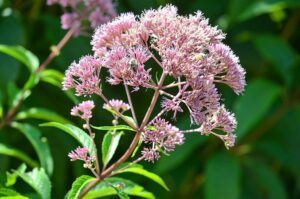Save Richmond’s Last Pitcher Plant Swamp
We have a rare opportunity to comment about a solar facility application (Case # PUR-2022-00179) that is proposed in Chesterfield County (south of Richmond) at a Natural Heritage “Irreplaceable” Site, which has numerous populations of rare plants and an expanse of intact native forests and woodlands that will be harmed if this project progresses. Tell…
Wildflower of the Year 2023 Hollow Joe-Pye-Weed (Eutrochium fistulosum)
VNPS offers Joe-Pye-Weed artwork on T-Shirts, Tote Bags, and Coffee Mugs. Visit our Online Store to order. Hollow Joe-pye-weed is a perennial herb that may grow as tall as 35 dm (about 11.5 feet). Stems are frequently purple and, when young, are covered with a thin, glaucous, layer of wax. Cross sections of stems will…
Wax Myrtle Sparkles in Winter
By Betsy Washington, Northern Neck Chapter Our evergreen Wax Myrtle or Southern Bayberry (Myrica cerifera) is handsome in every season of the year but it particularly sparkles in the winter after the leaves of deciduous trees have fallen leaving a gray and brown landscape. Not only are Wax Myrtles a beautiful native evergreen (large shrub…
Blue-Stemmed Goldenrod Lights Up Woodlands
By Betsy Washington, Northern Neck Chapter At our recent fall native plant sale a number of shoppers requested shade tolerant perennials that bloom in shady woodland gardens in late summer and fall, long after spring bloomers have faded. The October Plant of the Month, Blue-stemmed Goldenrod, Solidago caesia, fits the bill beautifully and like other…
Enchanting Blue Vervain
By Betsy Washington, Northern Neck Chapter Blue Vervain (Verbena hastata) enhances any landscape in which it grows. It is one of my favorite mid to late summer native perennials for any number of reasons. The beautiful purplish blue flowers atop tall stems provide a striking vertical accent contrasting with more typical mounded plants and flower…
Turk’s-Cap Lily Stuns in Summer
By Betsy Washington, Northern Neck Chapter Turk’s-cap Lily (Lilium superbum) is one of our most spectacular wildflowers in eastern North America. Its stunning flowers bloom right now in July and August. Native to wet meadows and rich moist cove forests and bogs from New Hampshire south to Georgia and Alabama, it is found in most…
The Curious Pawpaw
By Betsy Washington, Northern Neck Chapter The Pawpaw, Asimina triloba, is a handsome small tree that is as fascinating as it is curious. Pawpaw is a member of the Custard-Apple Family, the Annonaceae, a large family of tropical and subtropical species. Ranging from Florida and Texas north to New York and Southern Ontario, Pawpaw is…
The Spicebush Swallowtail Butterfly, Its Host Plants, and the New Threat They Face
By Mary Lee Epps A new non-native fungus and the beetle that carries it may soon severely impact sassafras, spicebush, and most other members of the Laurel family in the United States. Sadly, since these are the main host plants of the spicebush swallowtail butterfly, which is now common throughout most of the Eastern U.S.,…
Magical Mexican Dogwoods: What Should We Call Them?
By W. John Hayden, Botany Chair Who knew? Cornus florida, the 2018 VNPS Wildflower of the Year and State Tree of Virginia, has a cousin living in the mountains of eastern Mexico! Mexican Dogwoods have been found in the states of Nuevo Leon, Tamaulipas, and Veracruz. They are, manifestly, close relatives of the familiar Flowering…
Partridge-berry Is Bright All Year
By Betsy Washington, Northern Neck Chapter Partridge-berry (Mitchella repens) is a handsome evergreen vine that creeps along the ground reaching only 2” high. Its long trailing stems can reach 12” long but it develops roots at nodes along the stem wherever it touches the ground, creating large dense colonies. Widespread across eastern North America, it…










